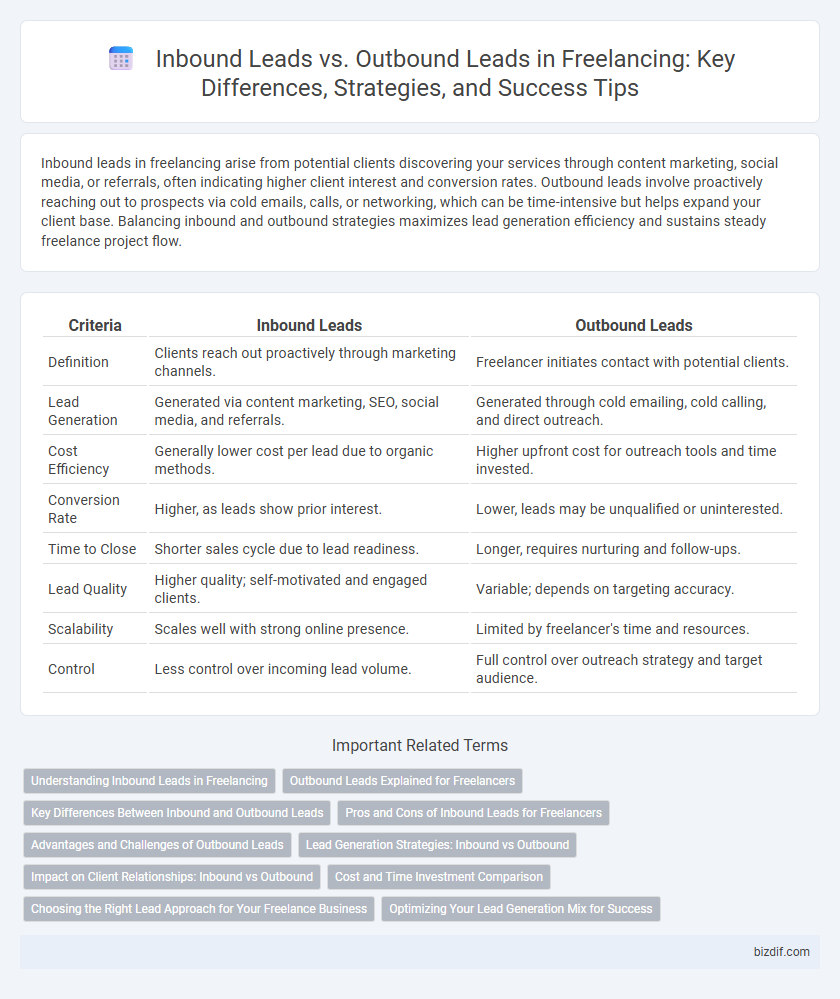Inbound leads in freelancing arise from potential clients discovering your services through content marketing, social media, or referrals, often indicating higher client interest and conversion rates. Outbound leads involve proactively reaching out to prospects via cold emails, calls, or networking, which can be time-intensive but helps expand your client base. Balancing inbound and outbound strategies maximizes lead generation efficiency and sustains steady freelance project flow.
Table of Comparison
| Criteria | Inbound Leads | Outbound Leads |
|---|---|---|
| Definition | Clients reach out proactively through marketing channels. | Freelancer initiates contact with potential clients. |
| Lead Generation | Generated via content marketing, SEO, social media, and referrals. | Generated through cold emailing, cold calling, and direct outreach. |
| Cost Efficiency | Generally lower cost per lead due to organic methods. | Higher upfront cost for outreach tools and time invested. |
| Conversion Rate | Higher, as leads show prior interest. | Lower, leads may be unqualified or uninterested. |
| Time to Close | Shorter sales cycle due to lead readiness. | Longer, requires nurturing and follow-ups. |
| Lead Quality | Higher quality; self-motivated and engaged clients. | Variable; depends on targeting accuracy. |
| Scalability | Scales well with strong online presence. | Limited by freelancer's time and resources. |
| Control | Less control over incoming lead volume. | Full control over outreach strategy and target audience. |
Understanding Inbound Leads in Freelancing
Inbound leads in freelancing result from potential clients discovering your services through content marketing, social media, or referrals, leading to higher-quality and more engaged prospects. These leads tend to have a greater conversion rate since they express active interest and trust in your expertise before initiating contact. Freelancers can enhance inbound lead generation by optimizing personal websites, showcasing portfolios, and maintaining strong online presence on platforms like LinkedIn and Upwork.
Outbound Leads Explained for Freelancers
Outbound leads for freelancers involve proactively reaching out to potential clients through cold emails, networking events, and social media outreach, targeting specific industries or businesses. This approach allows freelancers to control their sales pipeline by identifying and engaging with high-value prospects directly, increasing the chances of securing projects. Effective outbound strategies require personalized communication and consistent follow-up to convert leads into long-term partnerships.
Key Differences Between Inbound and Outbound Leads
Inbound leads originate from potential clients who actively seek out a freelancer's services through channels such as content marketing, SEO, or referrals, resulting in higher engagement and trust levels. Outbound leads involve the freelancer proactively reaching out to prospects via cold emails, calls, or direct messages, often requiring more effort to generate interest and convert. Inbound leads typically offer better conversion rates and cost efficiency, whereas outbound leads provide greater control over targeting specific clients and expanding outreach.
Pros and Cons of Inbound Leads for Freelancers
Inbound leads for freelancers generate higher conversion rates due to pre-existing interest, reducing time spent on prospecting and enabling focus on project delivery. However, relying solely on inbound leads can limit growth potential and create income unpredictability, as lead flow depends on market visibility and content marketing effectiveness. Freelancers must balance inbound strategies with proactive outreach to maintain a steady stream of diverse clients.
Advantages and Challenges of Outbound Leads
Outbound leads in freelancing enable direct targeting of potential clients, offering faster engagement compared to inbound methods. This approach allows freelancers to proactively showcase specialized skills and tailor pitches to specific industries, increasing conversion rates. Challenges include possible higher rejection rates and the need for sustained outreach efforts, requiring resilience and well-crafted communication strategies.
Lead Generation Strategies: Inbound vs Outbound
Inbound lead generation in freelancing leverages content marketing, SEO, and social media to attract potential clients organically, resulting in higher-quality leads interested in specific services. Outbound lead generation involves proactive outreach through cold emails, calls, and networking to target clients directly, often yielding faster but less qualified responses. Effective freelancing growth strategies combine SEO-optimized blogs, portfolio showcases, and targeted outreach campaigns to balance inbound and outbound lead pipelines.
Impact on Client Relationships: Inbound vs Outbound
Inbound leads foster stronger client relationships by attracting prospects who are already interested, resulting in higher trust and engagement levels. Outbound leads often require more effort to build rapport due to the proactive outreach approach, which can sometimes feel intrusive to potential clients. Prioritizing inbound strategies promotes long-term client loyalty and retention by aligning services with client needs from the outset.
Cost and Time Investment Comparison
Inbound leads typically generate higher return on investment due to lower acquisition costs and less time spent on outreach, as clients approach freelancers organically through content marketing, referrals, or SEO. Outbound leads demand significant time investment in personalized outreach, cold emailing, and networking efforts, which often result in higher cost per lead and longer sales cycles. Freelancers who optimize inbound strategies tend to maximize profitability by reducing marketing expenses and focusing time on project delivery rather than lead generation.
Choosing the Right Lead Approach for Your Freelance Business
Selecting the right lead approach for your freelance business involves understanding the differences between inbound and outbound leads. Inbound leads originate from clients who find your services through content marketing, SEO, and social media engagement, often resulting in higher quality and more motivated clients. Outbound leads require proactive outreach such as cold emailing, networking, and advertising, which can generate immediate opportunities but demand consistent effort and follow-up to convert.
Optimizing Your Lead Generation Mix for Success
Optimizing your lead generation mix involves balancing inbound leads, generated through content marketing, SEO, and social media engagement, with outbound leads, acquired via targeted email campaigns and cold outreach. Inbound leads tend to have higher conversion rates due to their pre-existing interest, while outbound leads allow proactive targeting of specific client profiles for faster pipeline growth. Combining data-driven strategies for both inbound and outbound approaches maximizes freelancing success by diversifying the client acquisition channels and increasing overall lead quality.
Inbound Leads vs Outbound Leads Infographic

 bizdif.com
bizdif.com